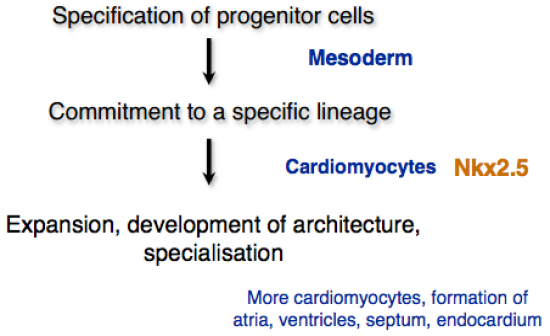Cards In This Set
| Front | Back |
|
Why study cardiovascular development?
|
- Embryos with cardiovascular defects often die
- Congenital heart dfects are the most common congenital defect in newborns - Developmental basis for adult disease - Developmental processes are often re-activated during cancer formation in the adult (eg leukemia) The formation of the cardiovascular system is an essential stage in the development of the embryo. Knockout (null mutant) mice are a crucial system for helping us define the roles of specific genes in cardiovascular development When mice are generated that lack a specific gene important in cardiovascular development they are often embryonic lethal |
|
What three lineages are needed for embryonic survival?
|
1. Hematopoietic
2. Cardiac 3. Endothelial - Major defects in any one lineage often leads to embryonic lethality - usually around 10.5 dpc in the mouse |
|
Why do we use mice to study cardiovascular development?
Why would we use a Zebra fish? |
Mouse embryo takes ~20 days from fertilisation to birth
- Embryo formed by 10.5 dpc (days post coitus - "knockout" mice: a specific gene is targeted and the function of the gene deleted Embryonic Lethality: death of the embryo in utero Zebrafish: Can develop embry on 48 hours, and can regenerate heart, if cut off can grow again. |
|
What does the cardiomyocyte-specific gene Ncx1 encode?
Why does a Ncx1 null mutation cause embryonic lethality?
Describe how the Ncx1 knockout mouse
was used to demonstrate the developmental origins of hematopoietic cells.
|
MY ANSWER: Ncx1 is a Na/Ca exchanger which is crucial for heartbeat regulation. Knockout results in apoptosis of developing cardiomyocytes. If there is no heart beath this will result in no blooc circulation and hence leds to embryonic lethality at E10.5.
MODEL ANSWER: Ncx1 is a sodium-calcium exchanger that is essential in the establishment and maintenance of the heart beat. Without a beating heart there is no blood circulation and the embryo dies at E10.5. An embryo without a heart beat and circulation can be used to identify the sites of hematopoiesis as the blood cells cannot migrate from the Yolk sac to the embryo body and to the placenta. Hence, the blood cells remain in their site of origin. |
|
What tool is used to allow us to image developmental processes?
|
Flourescent reporters.
|
|
What are embryonic stem cells?
|
Multipotent embryonic stem cells can be cultured and induced to form all the major cell types of the cardiovascular system.
|
|
What are the three germlayers, and which contains the cardiovascular system?
|
Extoderm (outer later): Skin
Mesoderm (middle layer): Everything between Endoderm (Inner layer): Tubes, digestive route The Mesoderm or the middle layer is the origin of most cell types forming the cardiovascular system: all endothelial cells, all blood cells, all cardiomyocytes, some smooth muscle cells, the heart. |
|
How do you form a complex 3-D structure like the heart from a thin layer of mesoderm?
|
 Three main steps: 1) Specification of progenitor cells 2) Commitment to a specific lineage 3) Expansion, development of architecture, specialisation |
|
What three layers make up the heart?
|
1. Epicardium (outer layer)
2. Myocardium (middle layer) - contractin cells 3. Endocardium (inner layer) |
|
Describe the major steps in embryonic heart development?
|
 E7.0 Cardiac mesoderm specification: heart fields appear E7.5 Cardiac crescent: 2 fields combine E8.0 Linear heart tube forms E8.5 Looped Heart E9.5 AV canal development E9.5 Endocardinal cushion formation E9.5 Trabeculation E10.5Outflow tract and aortic arch artery remodelling E13.5 to birth * These signals induce expression of cardiac-specific genes in the cardiac mesoderm |
|
Give one example of a transcription factor expressed in developing heart that when deleted (knocked out) results in embryonic lethality. Indicate the cell types
that express this gene, and briefly describe how deletion of this gene affects cardiac development?
|
MY ANSWER: Nkx2-5 is an important regulator in heart development as it is a master regulator of ventricle development. It controls the downstream expression of a wide range of genes essential for heart development and cardiac function. Knockout leads to embryonic lethality.
MODEL ANSWER: The main example discussed is Nkx2-5. Knockout of Nkx2-5 leads to embryonic lethality. Nkx2-5 is expressed in the developing heart tube by early cardiomyocytes and in the developing cardiomyocytes as they expand and form the different chambers. Deletion of this gene leads to runted embryos with no clear heart forming. |
|
Which two proteins specify the left and right atria and ventricles?
|
DHAND: Expressed in the right ventricle
eHAND: Expressed in the left ventricle |
|
How do we form heart valves?
|
Epithelial-mesenchyme transition: mesenchymal cell will push off endothelial cell wall to become the valves.
|
|
When does the embryo's first heart beat commence?
|
In Mouse: 8 Days
In Humans: 21 Days |
|
What is the difference between epithelial tubes and endothelial tubes?
|
Epithelia line the "outside" of our bodies. Basically, this is anything which is open to the outside, and includes the skin, the lining of our intestines, our bladder and urethra, etc.
Endothelia line the "inside" of our bodies, so this is the lining of our blood vessels, the lining of the chambers of the heart, etc. |



